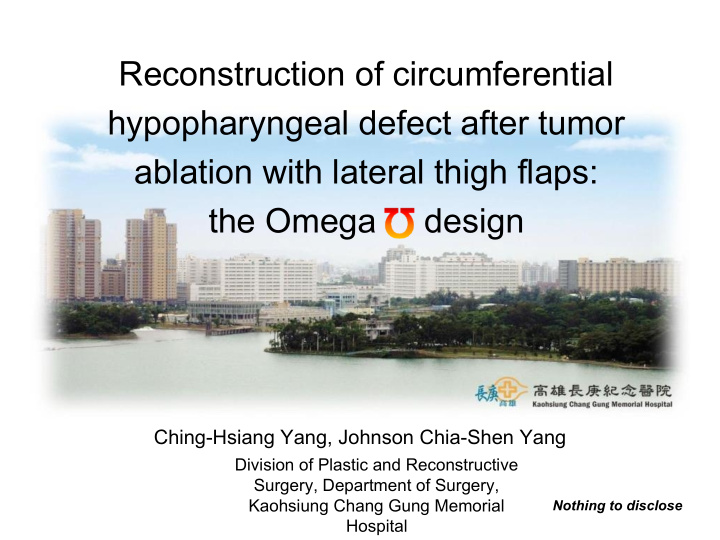



Reconstruction of circumferential hypopharyngeal defect after tumor ablation with lateral thigh flaps: the Omega design Ching-Hsiang Yang, Johnson Chia-Shen Yang Division of Plastic and Reconstructive Surgery, Department of Surgery, Kaohsiung Chang Gung Memorial Nothing to disclose Hospital
Introduction Tubular hypopharyngeal defect reconstruction choices Pectoralis major flap • Gastric pull-up • Free jejunal flap • Free radial forearm flap • Free anterolateral thigh flap • The disadvantages for these above-mentioned flaps: - Fixed lumen on both ends (mis-matched lumen) - No spare tissue for use
Flap Lumen mismatch Cervical esophagus
Object of this study To investigate the feasibility of Omega flap design to improve luminal mismatch for tubular hypopharyngeal defect reconstruction.
Patients and Method Sep 2009~ April 2014 - 63 free flaps for hypopharyngeal reconstruction - Patch 40; Tubing 10 - Omega flap tubing 13 (12 M, 1 F)
Omega Design (1) hypopharyngeal defect length = flap width
Omega Design (2) Excessive flap tissue
Omega flap Design (3) Perfect Lumen match Spare flap tissue outer stitch inner stitch De-epithelialized for double-breasted stitching
Omega flap Design (4) Spare flap tissue for Double-breasted Excessive flap tissue for neck skin defect stitching Neck skin defect reconstruction prn
Results - All flaps survived - - Donor site STSG: 6/13 - Wound infection rate: 30.8% - Fistula rate: 38.5% - Surgical debridement: 5/12 (41.7%) - Secondary reconstruction: Internal mammary artery flap (1)
Discussion (1) Advantages: Omega Design - Allows exact luminal match on both ends for smooth passage - Easier inset - Excessive flap tissue for: - Dead space - Double-breasted stitching - Neck skin defect reconstruction
Discussion (2) Disadvantages: Omega design - Slightly longer ischemic time - ALT donor site STSG (50%) - Double-breasted stitch is directly under neck skin incision line (10/12) 10 2
Discussion (3) - Fistula rate(38.5%); Wound infection rate (30.8%) Fistula: 9-33%. Wound complications: 25% Yu et al. Cancer. 2010 Apr 1;116(7):1718-24 Clark et al. Laryngoscope. 2006 Feb;116(2):173-81. - Possible causes: - Pre-op CCRT: 12/13 (92.3%) - Poor nutritional status (4 pre-op gastrostomy) - Huge wound - Suturing technique ?
Discussion (4) cervico- Double- Flap Laryngo- Spare esophagu Breasted comparison esophagus tissue s stitch Jejunal flap too small matched no no Radial matched too big no no forearm flap ALT flap matched too big no no (Spiral) ALT flap matched matched yes yes (Omega)
Conclusion - The quest for a perfect flap to reconstruct tubular hypopharyngeal defect continues. - This Omega flap design offers an alternative choice to enhance patient outcome. - More case number and long term f/u is needed.
Recommend
More recommend